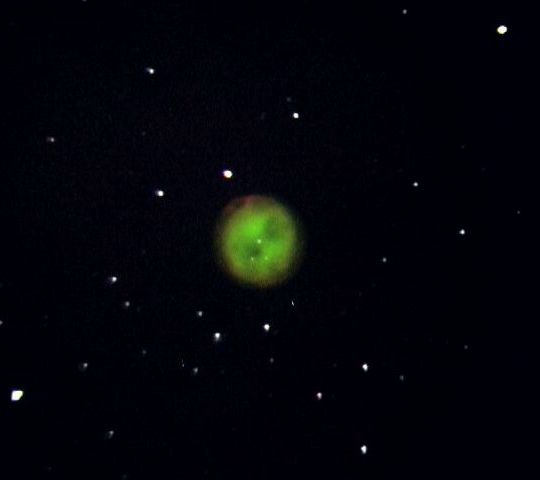

M 97, in the constellation of Ursa Major, is a planetary nebula. It was discovered by Pierre Méchain on 16 April 1781. It is believed to be about 6,000 years old, but its distance is very uncertain, estimates ranging from 1,300 to 12,000 light years.
When a star like our Sun reaches the end of its life, nuclear reactions in its core stop for lack of fuel, but can continue in layers further out. This results in the ejection of a significant part of the star to form a shell around the star. What is left is a very hot white dwarf the radiation from which stimulates the ejected gases to fluoresce. One of the most abundant elements involved is Oxygen which emits strongly at 500 nm in the green, so the nebula looks green to the human eye. (See footnote.)
 |
This image was made using the following filters: Luminance image: Orion Skyglow and IR-block filters, Red image: Astronomik Hα filter, Green image: Astronomik OIII filter, Blue image: Astronomik blue filter from the LRGB set. I tried to make an image with the SII filter but the nebula was extremely faint indicating no significant emission from Sulphur. The individual frames are shown below. Date and Time: 17th May 2010 22:15 to 22:26 UT Camera: MX716 with Astronomik Hα, OIII, and Blue filters Telescope: LX200 with 0.33 focal reducer Capture: star_mx7. 5 lum and 3 colour frames, 120" exposure Processing: star_mx7. Background, non-linear stretch 25. Registax. Stacked 4 lum frames, 3 colour frames. RGB image assembled in RegiStax LRGB image assembled in Photoshop. |

It is interesting to note that the 500-nm emission from doubly-ionized Oxygen (represented as [OIII] ) is a forbidden transition. This means that it breaks the rules of quantum mechanics, but not that it does not happen. An excited atom will decay to a stable configuration by whatever means it can. If the only route is a forbidden transition, the state is meta-stable which means it survives a long time (a microsecond or two, compared with a nanosecond or two for an allowed transition) before it decays. On Earth, even in our best vacuum, the atoms collide many times in this period and will lose their extra energy in the collision so the forbidden transition is not seen. However in space, with only a few atoms per cubic metre, the meta-stable state can last long enough for the forbidden transition to occur. Other forbidden transitions are the 672-nm SII emission and the 22-cm line from Hydrogen so important to radio astronomy. (See https://en.wikipedia.org/wiki/Forbidden_mechanism#In_astrophysics_and_atomic_physics )
Home Back to DSOs